 Facebook
Facebook
 X
X
 Instagram
Instagram
 TikTok
TikTok
 Youtube
Youtube
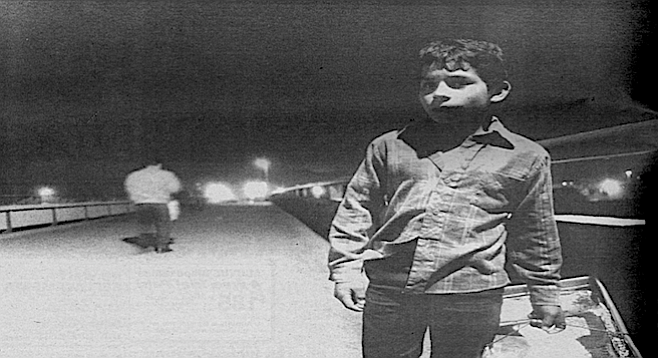
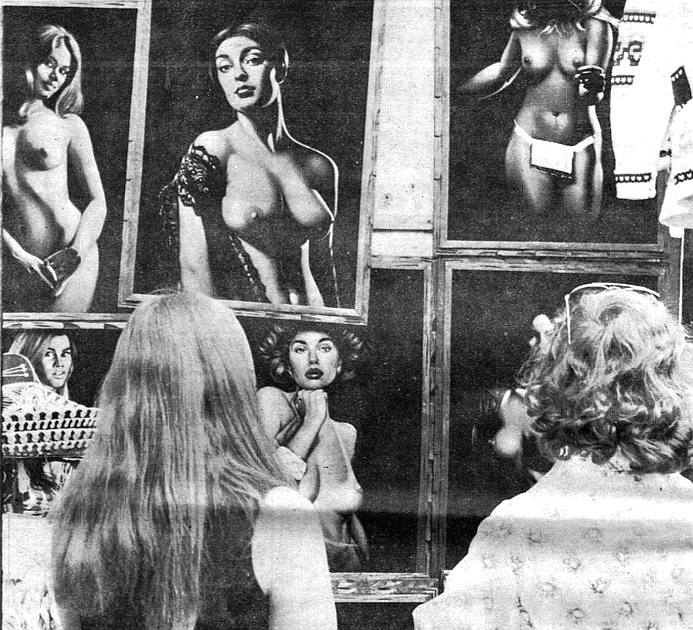
At Cali-Max, T-bone steaks were selling for 90 cents a pound, compared to American prices of about $1.88. Filet mignon, when bought uncut, costs around $1.30 a pound. Slabs of packaged jack cheese are sold for about $1.25 a pound, compared to $1.69 a pound here. And coffee—stronger and to some more flavorful than the American counterpart—costs $1.17 a jar (8 oz.) while it goes for $2.86 a jar (10 oz.) in the local San Diego supermarket.
By Bruce Gibney, Dec. 16, 1976 | Read full article
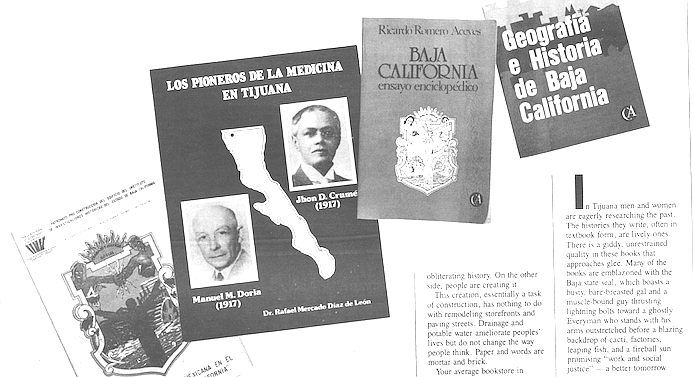
The book's initial chapters on the state’s original Indian tribes are spirited and bizarre. Spicy prehistory, complete with anatomically correct sketches. Naked women carry babies, hobo-style, on sticks thrown over their shoulders. Naked warriors stomp, grimace, and yell to scare off enemies. Indians “perforated the ears [of their children], the nose, and sometimes the lower lip,” so the kids could hang tiny creatures — spiders, lizards, and mice — from the incisions.
By Alfredo Antunez, Feb. 25, 1988 | Read full article
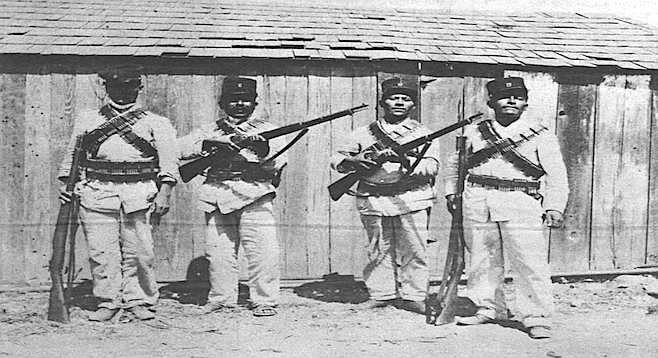
Pryce decided near the end of April to move on Tijuana. He ignored a message from Flores Magon in Los Angeles to attack the Diaz army at the Mexicali dikes. With approximately 220 men Pryce advanced on Tijuana. On May 8, the insurrectos reached the outskirts of Tijuana, at that time a village of about 1000 inhabitants. The commander of the government troops refused Pryce’s demand for surrender, and the fighting began the same evening.
By Bob Owens, Feb. 25, 1988 | Read full article
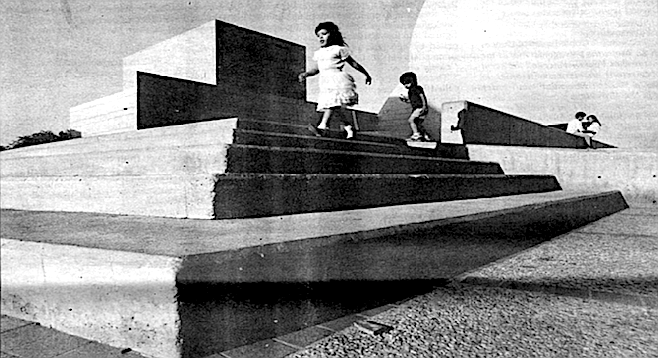
We were asked by Mrs. Lopez Portillo, the wife of the president of Mexico, to design an inaugural cultural building. We wanted to design a center with a promotional museum where people could see what Mexico is all about. For many years, Tijuana’s image was of a place of prostitution, a place to get drunk. That was it. That, of course, has changed, and we wanted the cultural center to be part of the change.
By Lawrence Herzog, June 13, 1991 | Read full article
The characteristic Tijuana opener, as ubiquitous as “What up, Cuz?” or “Happenin’, Homes?” across in bangerland, is que onda, guey? La onda means “wave” in the sense of “vibrations” and is hippie talk left over from the ’60s but is still ubiquitous among the hip. Que onda? is “What’s the vibes?” Buena onda means “good vibes” or “good people,” mala onda is a “bummer,” and otra onda is “something else” or “too much.”
By Linton Robinson, July 9, 1992 | Read full article

My first trip across: the late 1950s. We were on our way to visit relatives in Ensenada. We had driven all day from Sacramento in the blue DeSoto, and we reached the border around midnight. A fat Mexican in a brown uniform was making beckoning gestures in the light from our headlamps. This isn't Mexico, this isn’t Mexico, my mother kept saying, clucking, smoothing. Tijuana is just a border town; you see the worst here. You’ll see.
By Richard Rodriguez, Nov. 19, 1992 | Read full article
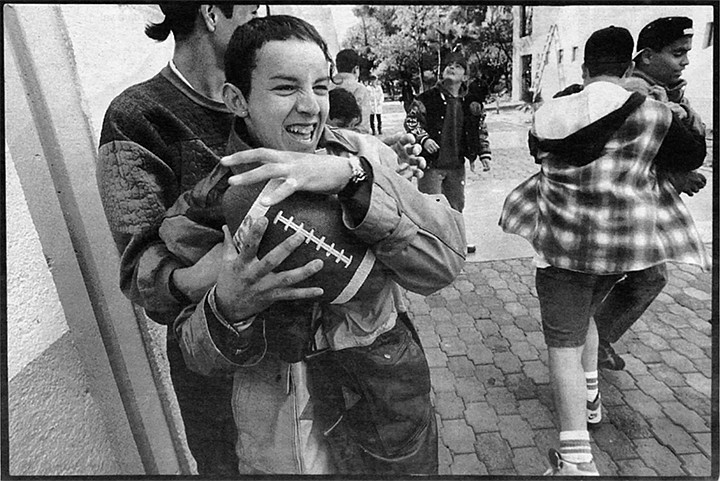
“There was a movement to standardize education in Mexico. Before 1982, the government said, there were more than a hundred different curricula in Mexico. If families moved, for example, from one state to another, their children would often have to retake classes. With the federal government supplying lesson plans, the teachers became lazy. It was as though they said to themselves, ‘Why do I have to think?’ So the teachers fell into a limiting rhythm of repetition.”
By Abe Opincar, March 24, 1994 | Read full article
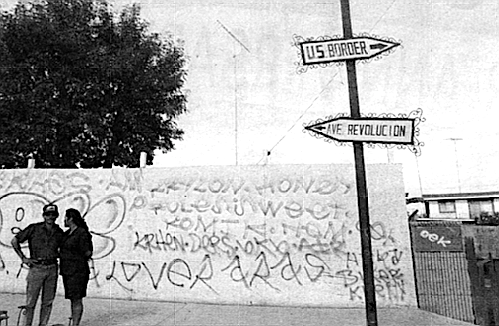
Henry and I explored Tijuana once again. We bypassed the saloons, drove out Avenida Revolution to the intersection of Calle Fundadores, then parked and climbed Calle Brazil, through a neighborhood of little stucco houses and modest apartments, past the Iglesia de la Merced. We gazed down a steep cobblestone road at Avenida Gonzales Bocanegra, on ground where the federal defenders of Tijuana probably ran toward the cover of brush and arroyos from the bullets of the rebels.
By Ken Kuhlken, Sept. 5, 1996 | Read full article
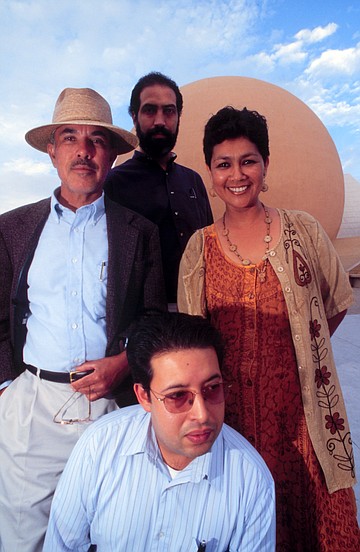
Tijuana’s literary society is small and incestuous and doesn’t keep its secrets for long. Unless you are de afuera, an outsider. If you are an outsider you may be treated with caution, but even then, it’s only a matter of time before the web of allegiances and jealousies — who was married to whom, or who slept with whom, or who denounced whom as an “embittered has-been” and at which drunken party this happened — is revealed to you.
By Abe Opincar, Aug. 5, 1999 | Read full article
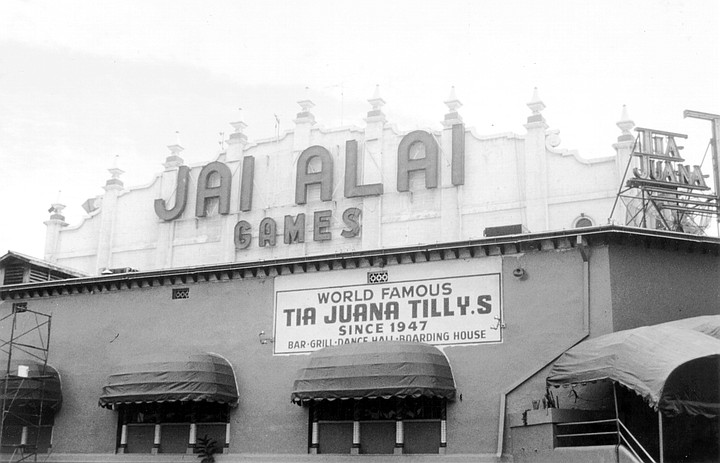
"Architecturally speaking, Tijuana is pregnant. We still don't know what the urban landscape is going to look like in the near future." The passing of recent decades has seen the 1920s tourism street scene recast in a new mold: serious, modernist, and international concrete highways, shopping malls, and industrial parks arrived. The old Tijuana is nearly extinct, the sex shows in dark Latin speakeasies relegated to a back lot — the Zona Norte — of the downtown.
Lawrence Herzog, March 9, 2000 | Read full article

Way out in the Lomas Taurinas district stands a large bust of Luis Donaldo Colosio near the spot where the presidential candidate was assassinated on March 23, 1994. Near downtown, on Second Street, between Streets H and I, stands a bust of Héctor Félix Miranda, the Tijuana journalist who was assassinated on April 20, 1988.
By Abe Opincar, Oct. 18, 2001| Read full article



At Cali-Max, T-bone steaks were selling for 90 cents a pound, compared to American prices of about $1.88. Filet mignon, when bought uncut, costs around $1.30 a pound. Slabs of packaged jack cheese are sold for about $1.25 a pound, compared to $1.69 a pound here. And coffee—stronger and to some more flavorful than the American counterpart—costs $1.17 a jar (8 oz.) while it goes for $2.86 a jar (10 oz.) in the local San Diego supermarket.
By Bruce Gibney, Dec. 16, 1976 | Read full article

The book's initial chapters on the state’s original Indian tribes are spirited and bizarre. Spicy prehistory, complete with anatomically correct sketches. Naked women carry babies, hobo-style, on sticks thrown over their shoulders. Naked warriors stomp, grimace, and yell to scare off enemies. Indians “perforated the ears [of their children], the nose, and sometimes the lower lip,” so the kids could hang tiny creatures — spiders, lizards, and mice — from the incisions.
By Alfredo Antunez, Feb. 25, 1988 | Read full article

Pryce decided near the end of April to move on Tijuana. He ignored a message from Flores Magon in Los Angeles to attack the Diaz army at the Mexicali dikes. With approximately 220 men Pryce advanced on Tijuana. On May 8, the insurrectos reached the outskirts of Tijuana, at that time a village of about 1000 inhabitants. The commander of the government troops refused Pryce’s demand for surrender, and the fighting began the same evening.
By Bob Owens, Feb. 25, 1988 | Read full article

We were asked by Mrs. Lopez Portillo, the wife of the president of Mexico, to design an inaugural cultural building. We wanted to design a center with a promotional museum where people could see what Mexico is all about. For many years, Tijuana’s image was of a place of prostitution, a place to get drunk. That was it. That, of course, has changed, and we wanted the cultural center to be part of the change.
By Lawrence Herzog, June 13, 1991 | Read full article
The characteristic Tijuana opener, as ubiquitous as “What up, Cuz?” or “Happenin’, Homes?” across in bangerland, is que onda, guey? La onda means “wave” in the sense of “vibrations” and is hippie talk left over from the ’60s but is still ubiquitous among the hip. Que onda? is “What’s the vibes?” Buena onda means “good vibes” or “good people,” mala onda is a “bummer,” and otra onda is “something else” or “too much.”
By Linton Robinson, July 9, 1992 | Read full article

My first trip across: the late 1950s. We were on our way to visit relatives in Ensenada. We had driven all day from Sacramento in the blue DeSoto, and we reached the border around midnight. A fat Mexican in a brown uniform was making beckoning gestures in the light from our headlamps. This isn't Mexico, this isn’t Mexico, my mother kept saying, clucking, smoothing. Tijuana is just a border town; you see the worst here. You’ll see.
By Richard Rodriguez, Nov. 19, 1992 | Read full article

“There was a movement to standardize education in Mexico. Before 1982, the government said, there were more than a hundred different curricula in Mexico. If families moved, for example, from one state to another, their children would often have to retake classes. With the federal government supplying lesson plans, the teachers became lazy. It was as though they said to themselves, ‘Why do I have to think?’ So the teachers fell into a limiting rhythm of repetition.”
By Abe Opincar, March 24, 1994 | Read full article

Henry and I explored Tijuana once again. We bypassed the saloons, drove out Avenida Revolution to the intersection of Calle Fundadores, then parked and climbed Calle Brazil, through a neighborhood of little stucco houses and modest apartments, past the Iglesia de la Merced. We gazed down a steep cobblestone road at Avenida Gonzales Bocanegra, on ground where the federal defenders of Tijuana probably ran toward the cover of brush and arroyos from the bullets of the rebels.
By Ken Kuhlken, Sept. 5, 1996 | Read full article

Tijuana’s literary society is small and incestuous and doesn’t keep its secrets for long. Unless you are de afuera, an outsider. If you are an outsider you may be treated with caution, but even then, it’s only a matter of time before the web of allegiances and jealousies — who was married to whom, or who slept with whom, or who denounced whom as an “embittered has-been” and at which drunken party this happened — is revealed to you.
By Abe Opincar, Aug. 5, 1999 | Read full article

"Architecturally speaking, Tijuana is pregnant. We still don't know what the urban landscape is going to look like in the near future." The passing of recent decades has seen the 1920s tourism street scene recast in a new mold: serious, modernist, and international concrete highways, shopping malls, and industrial parks arrived. The old Tijuana is nearly extinct, the sex shows in dark Latin speakeasies relegated to a back lot — the Zona Norte — of the downtown.
Lawrence Herzog, March 9, 2000 | Read full article

Way out in the Lomas Taurinas district stands a large bust of Luis Donaldo Colosio near the spot where the presidential candidate was assassinated on March 23, 1994. Near downtown, on Second Street, between Streets H and I, stands a bust of Héctor Félix Miranda, the Tijuana journalist who was assassinated on April 20, 1988.
By Abe Opincar, Oct. 18, 2001| Read full article
Comments